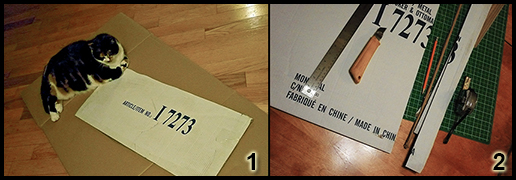 CFN -Further to the last Earth Matters column (and link http://www.thediyworld.com/DIY-Passive-Solar-Heating-Projects.html I decided to take some foil and cardboard in hand to see the level of complexity and the worthwhileness of incorporating such a tool in one’s home or workshop.
CFN -Further to the last Earth Matters column (and link http://www.thediyworld.com/DIY-Passive-Solar-Heating-Projects.html I decided to take some foil and cardboard in hand to see the level of complexity and the worthwhileness of incorporating such a tool in one’s home or workshop.
I changed some of the recommendations given in the above link as I wanted to include material that was easily within everyone’s reach instead of the Styrofoam suggested in the video above, namely cardboard, (see #1 with my supervisor Mi-mi) and I didn’t want to completely block a south facing patio door so I made the panel to cover the top portion of one side of our back patio doors.

The project/plan began with careful measurements of the area to be covered. The cardboard; (which I rescued from a neighbour who had put the cardboard out for garbage) which was double thickness and large as it was made to package a chair, was easily cut to measure using a box cutter blade and a steel straight edge. (see #2) It is advisable to protect the surface you are cutting on by using a cutting mat or some other material between your table and cardboard. I had decided to use Velcro tabs (see #3) to adhere the panel to the door frame. These were applied to the door frame and to the corresponding parts of the passive solar panel. This would hold the panel to the frame. The side that would be facing the sun was then covered in tin foil (see #4) and the seams were covered with high heat aluminum tape. (Can be found at your hardware store for about $7.00) Flat black, high-heat, spray paint specifically for metal (about $8.00) was purchased to cover the foil covered side in a well-ventilated area. I selected to use the open-doored garage as it was a nice but windy day. I laid down newspaper on the floor to keep the floor clean from any overspray. The painting was done in two coats as recommended on the paint packaging. The panel was now ready to install.

The panel was easily installed with the Velcro strips. (#5 shows the installed, painted panel from the outside with the lower ventilation opening) Within a short period of time the upper ventilation hole was moving hot air into the room where it was housed in spite of the fact that it was only a partial panel. I did not have gadgets to measure the difference of the air temperature between the one side of the panel covered patio doors and the other side without; however judging by the senses of my hands the passive solar panel was providing additional heat to the space. Success!!
The initial success of this experiment quickly showed the areas the required rethinking as the adhesive (not made for high heat applications) of the Velcro tabs lost their grip on the cardboard within hours and slipped to the floor. The panel has now been relegated to a guest bedroom where it can easily rest on the window sill as I continue to survey it’s functioning in the days ahead.
This is definitely a project which is worthy of consideration and perhaps your own modification. There are various DIY (do it yourself) passive solar projects on line if you wish to do some research. I would keep in mind the following changes when making another panel. I would look for a way to hang the panel in the window frame rather than using the Velcro tabs unless there were some available with a high heat application adhesive. Consider covering the panel side facing the indoor of the space with some simple or painted fabric to lend a finished look to the panel and room. A solid piece of tin plating would also be worth considering depending on cost, availability and ease of manoeuverability.
If you decide to try a passive solar project of your own, we would love to hear about your results. Please do share.
Your commentary is always welcome and greatly appreciated below or to earthmatters@jmilner.com


This is a great diy passive solar project, and very simple one so everyone could do it. I have been researching active solar heating for some time and last year I build a do-it-yourself pop-can solar panel heater. It has enormous power (almost 2KW) and those who are interested should definitely try to build one. There is a great on-line guide at . I would keep in mind that beside constructing a solar device, you are recycling pop cans so there is a huge benefit for the environment.
Thanks for the share McMillan…greatly appreciated.
Please keep us posted on your findings from the performance of the panel. I do not have any south facing windows and am not handy like you but am very interested in alternatives to gas and fuel. An excellent column! Thanks!
On article on the Passive Solar house of Tracey Allen of T Allen Consulting…thanks for the share Tracey. http://www.theguardian.pe.ca/Arts/Entertainment/2012-11-03/article-3113126/Seeing-the-light/1
Check out their video house tour on YouTube http://youtu.be/33IWs4H3kL4